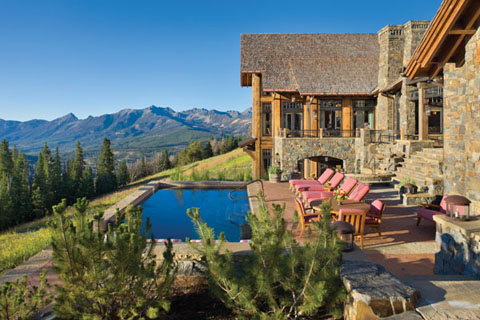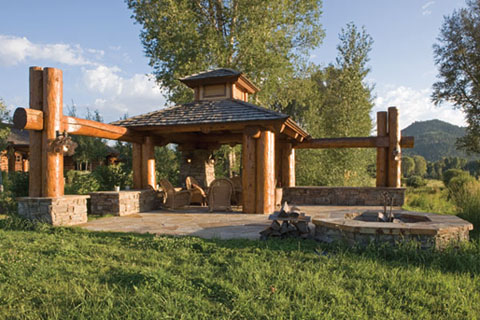Living next door to the outdoors holds the greatest appeal for log home owners, and making the most of outdoor living space is steadily rising on the wish lists of those building and buying new homes or enhancing existing outdoor amenities. From wraparound porches and extended decks to patios, pergolas, pools, and full kitchens, creativity and craftsmanship drive spectacular results.
“We just started a line of outdoor living spaces two years ago,” relates Stephanie Johnson, marketing manager for PrecisionCraft Log & Timber Homes. “It made sense for us as a natural extension of what we do, and there weren’t that many options on the market that include substantial handcrafted logs going beyond a builder just doing a pergola. There has been a general trend toward outdoor structures that extend a home’s living space and provide an additional area to entertain.”
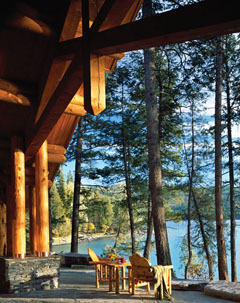
Malmquist Construction/photo by Heidi Long
With numerous styles to choose from, the PrecisionCraft line works seamlessly with existing log or conventional structures. If construction may be some years in the future, property owners may want to begin enjoying their space right away by parking an RV next to an outdoor space or simply building that ideal fireplace and gathering spot early in the process.
With outdoor spaces, PrecisionCraft follows a process similar to other log home projects, providing design and specification support along with the logs and timber needed to complete the project. From the beginning, a consultative approach includes consideration of cost, usage, climate, and personal preference.
“If someone is going through the design process, it is best to think about outdoor space ahead of time and consider it an extension of the home,” advises Johnson. “Think about scale. Often, people forget about that, and gigantic logs don’t always go well with a smaller home. Remember to envision how the space will be used and whether there is a lot of snow or sun or temperature fluctuation in the area. Climate dictates the amount of open and closed space and the time that can be spent outdoors.”

Landmark Builders/photo by Heidi Long
At Log Homes of America, National Sales Manager Jeremy Bertrand sees customers gravitating toward shed porches and roof extensions to cover wide, sweeping decks as more and more people are asking to incorporate outdoor living space in a comprehensive design plan. “The word is getting out about it,” he comments. “We do a lot of webinars and seminars at shows, and there is always strong interest in outdoor spaces. I think the trend has a lot to do with values. There is definitely a direct correlation between a log home and outdoor activities, so people are looking for a nice porch to sit out on and enjoy.
“A wood-burning fireplace is an outdoor staple, and we do gas as well, depending on what the customer wants,” Bertrand continues. “We have actually done a covered great room with a two-way fireplace visible from inside or outside. For homes here in North Carolina, where we are located, we have done stone patios and wraparound porches, working with our customers as their cash flow allows.”
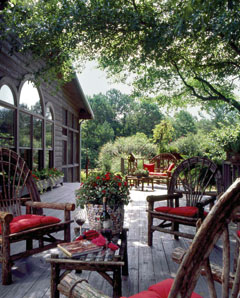
Photo by Franklin & Esther Schmidt
Swimming pools with private changing facilities, expansive sitting areas where homeowners enjoy a morning cup of coffee or an evening glass of wine, and full outdoor kitchens are among popular options for extended living space. Green building standards are incorporated in the planning process at Log Homes of America as well.
“The look of an outdoor living space can be tremendous,” Bertrand adds, “and I am a big believer in where the customer wants to spend his or her money. If they want a covered deck or a shed porch, it makes sense to complete those during construction to save money, but most outdoor living spaces can be added at a later time if the owner chooses to wait.”
In thinking about amenities, Bertrand urges customers to assess the prevailing climate and then evaluate the amount of use certain additions may actually get. “Location, location, location. In the mountains there is little humidity and there are no bugs to speak of, so outdoor living space is great, but if mosquitoes are a problem the homeowner may decide to do some screened space. Coastal areas have wind zones, and the building regulations are often more stringent. For situations like that, we have done screened space with storm shutters or storm drapes.
“Of course,” he concludes, “it is also advisable to think about things like hot tubs. You either use them a lot or you don’t. Some people put hot tubs in and use them once or twice and then they are covered and not used again.”
The natural integration of outdoor living space has gained substantial momentum in the last decade according to Ron Volz, vice president of Tomahawk Log & Country Homes. Building the right kind of space and safeguarding it against the elements maximizes the length of time it can be enjoyed from season to season.
“Screens or retractable storm windows can extend the length of time a space can be used from summer into the early fall or winter, or from late winter to early spring,” Ron relates. “We have used screening devices that are remote-controlled to extend the usable hours in a single day depending on whether conditions are rainy or windy or a lot of bugs are present.”
Tomahawk provides design consultation on attached or separate outdoor structures, including gazebos tucked in a corner of a property so that adults can gather away from playing children or the children can have space of their own separate from parents enjoying quiet conversation.
“I would advise consulting with a landscape architect so that the outdoor space is truly an extension of the living area rather than an afterthought,” comments Volz. “The bulk of our business is new construction, and through the use of photos and visits to model homes, we can show customers how exciting outdoor spaces can be. We encourage them to consider the outdoors from the get-go.”
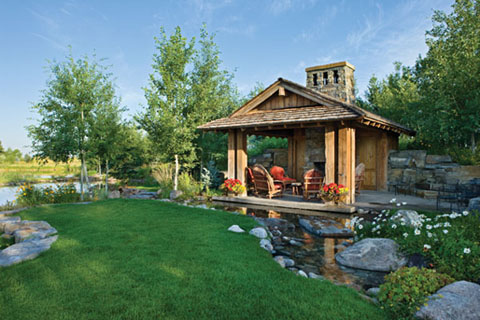
Locati Architects; Locati Interiors; Schlauch Bottcher Construction, Inc./photo by Roger Wade
Combinations of log and stone can be striking, particularly when an outdoor kitchen is part of the plan. Purchasing a package of outdoor appliances, setting them into mortar faced with cut stone, and covering the area with a log or timber structure offers a spectacular option. “Kitchens should be well thought out,” says Volz. “Some people want only a gas grill and a small food preparation area, while others want a full-blown cooking center, and we have seen the spectrum.”
In addition to managing temperature extremes for maximum usage time, Ron says homeowners should incorporate dramatic accent lighting, sometimes recessed with a dimmer to add ambience, and hang a ceiling fan or two to circulate air.
With imagination and preparation, log home living can become even more satisfying with unforgettable outdoor space customized to fulfill the vision of those who will enjoy it for years to come.

